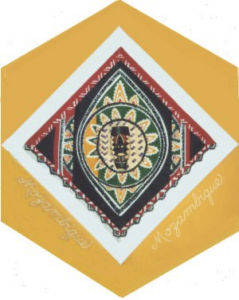Mozambique

The Block
A miniature carving, positioned on a woven straw mat, is the central figure of the Mozambique block. The piece was reproduced to resemble the carved wooden sculptures and masks for which the Makonde people are so well-known. One of the country’s most sophisticated art forms, these unique and individually crafted works are traditionally carved in ebony, quite often from a single log of wood. Block-maker, Annetta Chicogo’s mother––inspired by Mozambique’s newly gained independence in 1975––designed the background fabric, which is a printed cotton featuring a stylized sun (symbolic of the country’s new beginning) and other geometric motifs in national colours
Cultural Profile
Mozambique, formerly known as Portuguese East Africa, is a republic located on the south-eastern coast. The Limpopo––made famous by Rudyard Kipling’s ‘The Elephant’s Child’––and Zambezi Rivers (two of southern Africa’s longest rivers) flow through the country. The region is home to the rare, and endangered, black rhinoceros. In 1990 the nation was estimated to be the world’s poorest country, however Mozambicans have worked diligently in recent years to rebuild their homeland which had been decimated by civil war. While a large part of the population still engages in subsistence agriculture and a traditional way of life, natural resources such as hydroelectricity, coal, gemstones and natural gas are fuelling the country’s economic development and modernization.
The country’s ethnically and linguistically diverse population is comprised primarily of indigenous tribal groups, including the northern Makua and Makonde, the central Sena, the coastal Chopi, and the southern Shanagaan. While each group speaks its own tongue, the official language is Portuguese, which is spoken as a second language by half of the population.
Mozambique has a rich artistic tradition that continues to thrive despite years of turmoil. It produces some of Africa’s finest art, including the haunting paintings of Malangatana, which have been exhibited worldwide. It is known for its murals reflecting stories and images of historical events, the largest and most famous measuring 95 metres in length. The Makonde are also renowned for their woodcarvings in ebony, mahogany and ironwood.
Although the written word has become more important in the 20th century, there is still a strong oral tradition in which preserved stories are passed from generation to generation. Traditional music, which differs regionally, is an important aspect of the culture. The Makonde are noted for wind instruments, such as the lupembe, while the Chopi people are famous for midogo, which are complex orchestral performances, featuring the timbila, a type of xylophone. Timbila orchestras often accompany lively song and dance performances that reflect village life. The mbira, a large thumb piano built into a calabash resonator, is also played in the country, while guitars are used extensively in non-traditional styles such as kizomba, hip hop, marrabenta or fado.
Dance is among the country’s most highly developed art forms, and the Companhia Nacional de Canto e Danca (National Song and Dance Company of Mozambique) is one of Africa’s greatest cultural treasures. The Company draws upon the country’s rich and diverse culture with the goal of preserving and performing the expressive art forms of Mozambicans. Traditional dances include the Makway and Ngoma, while a contemporary piece called The Sun Has Up-Risen celebrates the country’s independence.
Few Mozambicans have immigrated to Canada and their numbers remain small.
Sponsor: Cornwall Honda
